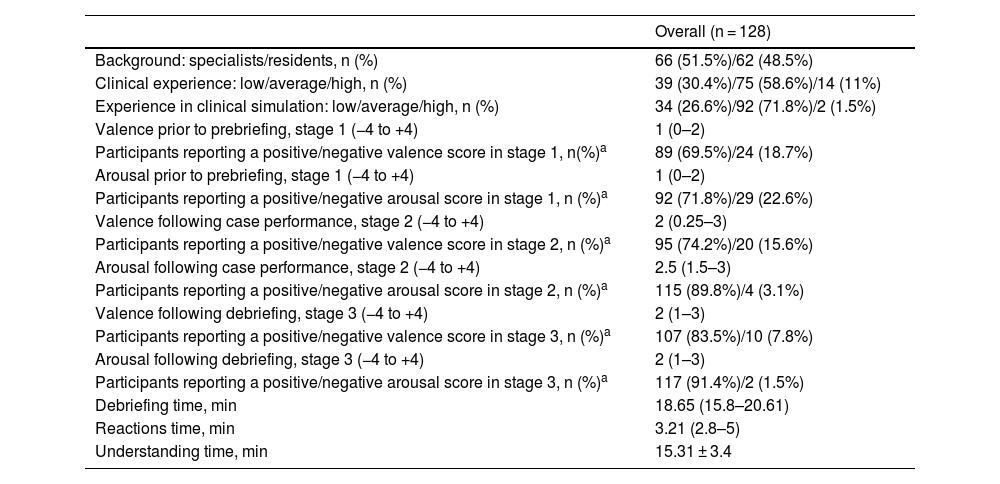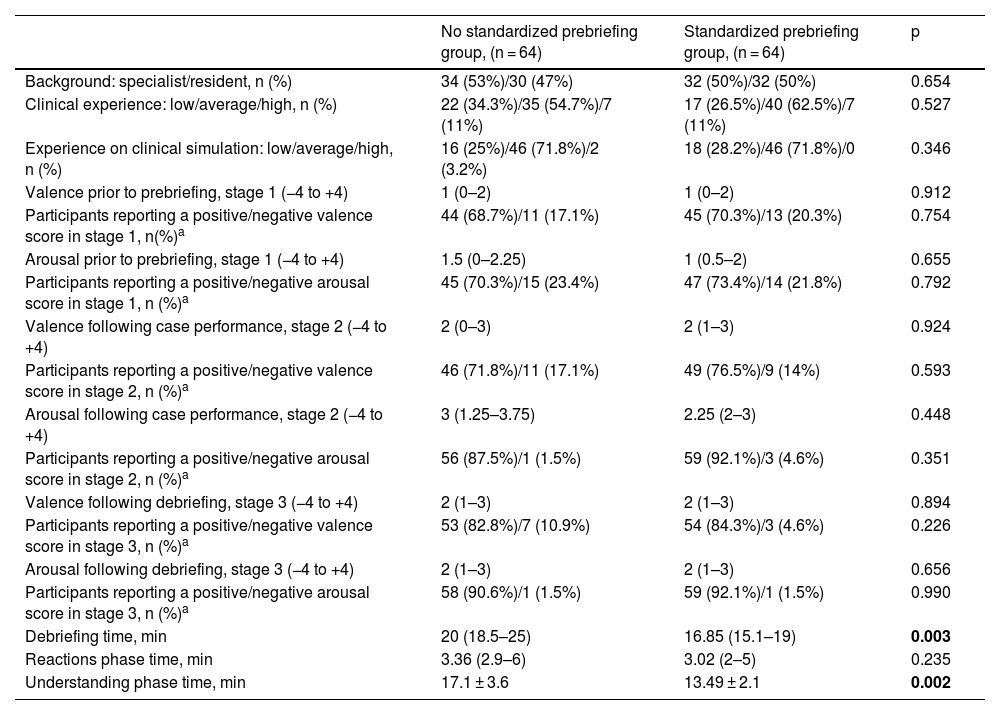Medical simulation is associated with intense emotions which influence human behavior. We aim to investigate how prebriefing impacts on learners’ emotions during a high-fidelity simulation (HFS) session.
MethodsThis is a prospective randomized controlled study. Participants were randomly allocated to receive a standardized prebriefing (SP group) versus not receiving it (NSP group). Debriefing following the «good judgment» approach, structured in reactions, understanding and summary phases, was used in both groups. In order to assess emotions, we used the circumplex model of affect applying the Affect Grid scale, which was performed prior to prebriefing, following case performance and following debriefing. Debriefing times were also assessed.
ResultsA total of 128 physicians participate in the study (64 vs. 64). Following case performance, this HFS session was experienced with significantly more pleasant emotions compared to baseline, that were maintained during debriefing (p < 0.01) while alertness increased after case performance diminishing after debriefing (p < 0.01). There were no statistical significant differences between groups. In the NSP group, total debriefing (p = 0.003) and understanding phase (p = 0.002) times were significantly longer.
ConclusionsThis HFS session was experienced as pleasant with high alertness with no specific emotional impact attributable to prebriefing. Prebriefing leads to a freer flowing debriefing.
La simulación médica está asociada a emociones intensas, que influyen en el comportamiento humano. Nuestro objetivo fue investigar el modo en que el prebriefing repercute en las emociones de los alumnos durante una sesión de simulación de alta fidelidad (SAF).
MétodosEstudio controlado aleatorizado prospectivo. Se asignó aleatorizadamente a los participantes para recibir un prebriefing estandarizado (grupo PE) o no recibirlo (grupo NPE). Se utilizó en ambos grupos el debriefing tras el enfoque de «buen juicio», estructurado en fases de reacciones, comprensión y resumen. A fin de evaluar las emociones, utilizamos el modelo circunflejo de afecto aplicando la escala Affect grid antes del prebriefing, tras el desempeño del caso y tras el debriefing. También se evaluaron los tiempos de debriefing.
ResultadosParticiparon 128 facultativos en el estudio (64 frente a 64). Tras el desempeño del caso, la experiencia de esta sesión de SAF reflejó emociones significativamente más agradables en comparación con el nivel basal, que se mantuvieron durante el debriefing (p < 0,01), mientras que el nivel de alerta se incrementó tras el desempeño del caso y disminuyó tras el debriefing (p < 0,01). No se encontraron diferencias estadísticamente significativas entre los grupos. En el grupo NPE, los tiempos totales del debriefing (p = 0,003) y de la fase de comprensión (p = 0,002) fueron significativamente más prolongados.
ConclusionesLa experiencia de esta sesión de SAF fue agradable y con elevado nivel de alerta, sin impacto emocional específico atribuible al prebriefing, lo que da lugar a un debriefing con un flujo más libre.
Artículo
Comprando el artículo el PDF del mismo podrá ser descargado
Precio 19,34 €
Comprar ahora












